AUSTRALIA
Plants and Animals
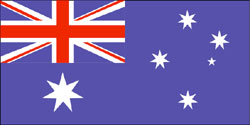
Plants and Animals
Cities in AUSTRALIA
| Adelaide | Brisbane | Canberra |
| Melbourne | Sydney |
Plants and Animals
Plants
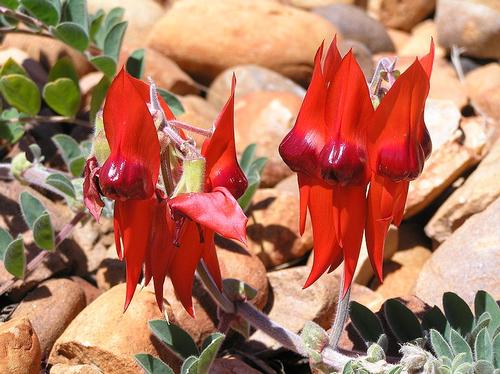 Sturt's Desert Pea AustraliaPhoto: Public domain
Sturt's Desert Pea AustraliaPhoto: Public domain
Many tens of millions of years ago, much of Australia was covered by rainforests. In the Ice Age, the water disappeared and the continent dried out, except in Queensland. Instead, new plants such as eucalyptus and acacia were introduced. From that time on, the Australian plant world formed a separate flora kingdom, called Australis. Many species only occur on this continent.
Many forests were felled by Europeans to serve as pasturage and for timber extraction. Also seeds from imported plants and animals that ate the land had a negative effect on the native plant world. Most plant growth occurs in rain areas such as the northeast, southwest, southeast and Tasmania. The interior is especially very dry, but can become a sea of flowers and plants for a short time after a heavy rain shower. The red-black Sturt's desert pea is especially unsurpassed. In the dune deserts mainly hedgehog grass and thick-leaved salt herbs grow on the salt flats. The Australian bushy white-feathered grass is called Spinifex and is found in the steppes and deserts. Despite everything, there are some 25,000 different types of flowering plants throughout Australia.
One of Australia's major plants is the eucalyptus or gum tree. There are about 700 species in the world, 95% of which are in Australia. The most common species are found in Western Australia, Victoria, New South Wales and Queensland. Tasmania, South Australia and Northern Territory have the fewest species. There are small varieties such as the "mallee" and the "snow gums", but also varieties that can reach a height of more than 50 meters, such as the "mountain ash", the "jarra" and the karri tree. Economically, the trees are important for lumber and for the production of eucalyptus oil.
About 700 species of acacia also occur in Australia. They range from ground covers and shrubs to trees that can grow up to ten meters high. Acacias can be found everywhere, both in the dry interior and in the rainforests. The most common species are found in Victoria and Queensland. Australia owes the national colors gold and green to the "wattle", the Australian acacia.
The melaleuca or paper stem is represented in Australia with 150 species, most of which are native. Both small shrubs and trees with a white, peeling bark grow up to 10 meters high. Most species are found in Western Australia and New South Wales. There are no melaleucas in Northern Territory.
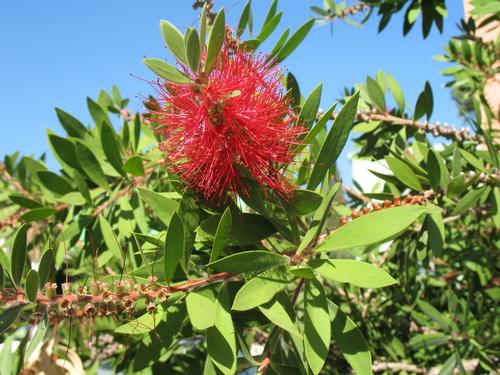 Banksia AustraliaPhoto:Public domain
Banksia AustraliaPhoto:Public domain
Banksias are shrubs and trees up to 15 meters high that remain green all year round. They often grow in areas where conditions are not too favorable, e.g. on poor coastal soil, sandy moorland and barren sandstone earth in mountain areas. The special thing about these plants is that they can only multiply during forest fires! Only then will temperatures rise to such an extent that the seeds will burst from their shells.
Grevilleas come in many varieties that often hardly look alike. There are 250 varieties that grow close to the ground but can also grow up to 30 meters high. The flowers are also called "spider flowers" and the leaves differ in shape and color depending on the species.
Baobabs are only found in Western Australia and Northern Territory. They can reach 20 meters in height, but the trunk can reach a size of 20 meters. They also occur in the dry areas because the huge trunk can absorb large amounts of water.
Grass trees are found all over Australia. The thick black trunk can reach 6 meters in length and eventually grow grass-like leaves, hence the name. This ancient tree species has been found in Australia alone for 100 million years and survives the most extreme conditions such as drought, floods and fire.
Casuarina's are also everywhere and have needle-like leaves.
The national flower of Australia is the "kangaroo paw". Tasmania is the domain of the southern beeches and one of the longest living trees on earth, the "Huon pine".
Across the continent there are about 470 orchid species.
Western Australia is different in many ways from the rest of Australia, including in terms of plant growth. The state is home to about 8,000 varieties of flowering plants such as the ground orchid, the red and green kangaroo foot, the blue leschenaltias, the dryandra, the banksia, and carnivorous plants such as the drosera or sundew.
In 2003, Australia's tallest tree was officially declared dead. El Grande stood in Tasmania and fell victim to a devastating forest fire. The eucalyptus was 350 years old and 79 meters high.
Animals
Australia is the only continent where all three subclasses of the mammals are found: the real mammals, marsupials, and the egg-laying mammals.
The mainland of Australia, like New Guinea, Tasmania, New Zealand and a number of islands in the Pacific Ocean, is part of the animal geographic area of Notogaea and is also referred to as the Australian Region or the South Kingdom. The very special fauna shows the curious history of Australia after the break-up of the southern supercontinent Gondwana. On the other hand, Australia's isolated location has created an animal world unlike any other in the world.
The stromatolites in Shark Bay, Western Australia, are millions of years old and the most primitive life forms in the world. They look like stones, but are actually slow-growing spongy plants, formed by tiny unicellular algae.
In March 2016, a new spider species was unveiled at the World Science Festival in Brisbane. Named Dolomedes briangreenei, the spider was discovered along the east coast of Australia, in and around Brisbane.
Mammels
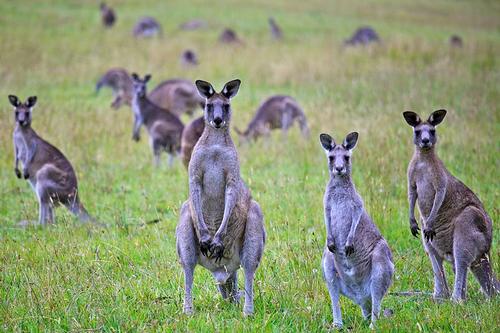 Kangaroo AustraliaPhoto: Alex Proimos CC 2.0 Generic no changes made
Kangaroo AustraliaPhoto: Alex Proimos CC 2.0 Generic no changes made
Almost all higher developed orders are missing among mammals; the approx. 235 species consist of half marsupials (Marsupialia) and egg-laying mammals (Monotremata or beak animals) and half of modern mammals (Placentalia). The last category consists exclusively of bats and rodents. This category also includes the dingo, a feral dog that was introduced long before the arrival of the whites. The dingo cannot bark, but howls louder.
The many marsupials may have arisen as a result of low or missing competition in terms of ecological potential. Due to the lack of competitive modern mammals, the marsupials in Australia have started climbing, swimming, digging, etc., specializing in different types of food. Insectivores, rodents, predators and other types are therefore among the marsupials. Of the sixteen marsupial families in the world, thirteen live exclusively in Australia. Young marsupials are not fully developed at birth and therefore the mother keeps them in a fold of skin called the pouch until the young are strong enough to move independently in the outside world.
In addition, due to human intervention, a number of animal species from elsewhere have displaced the original fauna. The most notorious animal is undoubtedly the rabbit, introduced in 1859 as hunting game and quickly becoming a real pest. Herds of dromedaries live in Central Australia, brought to Australia by explorers. Buffalo herds are found in northern Australia, east of Darwin. Wild horses or brumbies descended from the horses that came from the mainland in the nineteenth century on Fraser Island.
Kangaroos and kangaroo-like wallabies, wallaroes (mountain kangaroos) and pademelons are marsupials. The largest species is the red giant kangaroo that can grow up to two meters. There are about fifty species, including the mountain kangaroo, the quokka or rat kangaroo, the smallest species still found only on Rottnest Island in Western Australia. On the east coast, the most widespread species is the gray giant kangaroo.
The platypus is one of the most remarkable apparitions in the animal world. The animal has a duck's beak, a beaver's tail and webbed feet; in addition, the animal lays eggs, but suckles their offspring. The very shy animal is still quite common in Tasmania and east of the Great Dividing Range.
The rare mountain pygmy opossum, a unique alpine marsupial, lives on the high peaks of Mount Bogong, Mount Buller and Mount Hotham in Victoria.
The koala or marsupial bear is not a bear, but a marsupial, and lives almost exclusively from certain types of eucalyptus leaves, including the red gum tree and the blue gum tree. These leaves contain so much water that it does not need extra water. The koala mainly lives in the states of Victoria, New South Wales, Queensland and to a lesser extent South Australia. The name koala is taken from the language of the aborigines and means "who does not drink that".
The wombat is related to the koala, only this marsupial lives on the ground and they are mainly found in Tasmania and in the southwestern coastal strip. They are vegetarians who cannot tolerate heat and therefore often look for roots, leaves and bark at night. The wombat is the only rodent among the marsupials.
The echidna is an egg-laying mammal, is found all over Australia and eats ants and termites.
Opossums are possums that look like large squirrels. Some opossums have a fly skin that allows them to fly from tree to tree. Marsupial squirrels also live in trees and can float through the air.
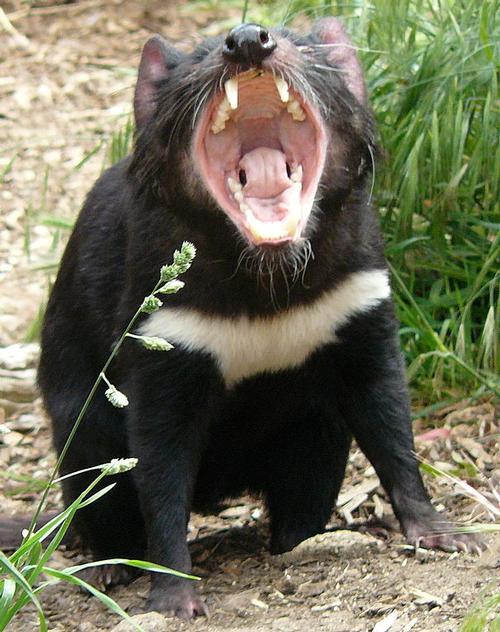 Tasmanian devil AustraliaPhoto: Macropod CC 3.0 Unported no changes made
Tasmanian devil AustraliaPhoto: Macropod CC 3.0 Unported no changes made
The Tasmanian devil is a black predator that lives on the island of Tasmania in small burrows, in rocks and in old tree stumps. It has been wiped out by the dingo on the mainland, and the animal is also threatened with extinction in Tasmania. The Tasmanian tiger is a predator with transverse stripes on its back and was last officially seen in Tasmania in 1930. The animal is believed to be extinct. In May 2002, it was announced that Australian scientists would like to bring the extinct Tasmanian tiger back to life. Professor Mike Archer found a well-preserved embryo of the animal in a museum. Research showed that the DNA was still intact. The professor thinks he can clone the beast.
The numbat is a termite eater and a marsupial without a pouch. The young cling to the mother's fur. The animal is very rare and is only found in the south and west of Australia.
The common brush-tailed possum is a treat for the aborigines. The animal is so widely spread that it is almost a pest. They already live in and around almost all Australian cities and nest in burrows in gardens and even in attics.
Kangaroo Island is located off the coast of South Australia and is home to New Zealand seals and a rare sea lion colony for Australia.
In Shark bay the dugong, a manatee and the world's only herbivorous sea mammal can be found.
The smallest carnivore is the yellow-footed antechinus. This animal weighs only 50 grams and can be found in the "bush", the unexplored nature, near the cities on the east coast. The small animals have a very fast metabolism and are therefore always looking for food: insects, small birds and lizards. The sex act is such an exertion for the animal that it dies a few days later.
Birds
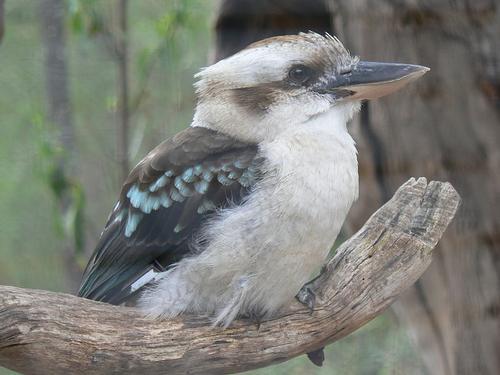
The Australian bird world has about 650, often very special species. Endemics include birds of paradise and bowerbirds (both also on New Guinea), the lyrebirds, honey suckers and the ostrich-like emu. The emu is a flightless bird and, after the ostrich, the largest bird (1.5 meters) in the world, found everywhere except on the east coast and Tasmania. The emu is found on the coat of arms of Australia. The cassowary is related to the emu, but much smaller in size. It is mainly found in the rainforests of Queensland and when threatened it jumps up and makes a kicking motion with its legs. The lyrebird is also a flightless bird with beautiful tail feathers and lives in the forests of the southeastern mountain landscape.
Australia is very rich in parrots (55 species; second in the ranking after Brazil), parakeets, cockatoos (rosé cockatoo, black raven cockatoo, yellow-tailed cockatoo), lories, kingfishers and pigeons.
In addition, there are many peculiar species such as the black swan and the giant kingfisher or kookaburra.
Bowerbirds build a "gazebo" with which they try to lure the female and are decorated with preferably blue stones, pieces of glass and other knickknacks. The structure is not used as a nest.
Birds of prey include kites, hawks, Australian eagles, sea eagles, ospreys, and falcons. In the marshes there are herons, the brolga crane, magpie geese, spoonbills, ibises, and the lotus bird. Along the coast live such familiar apparitions as albatrosses, black-winged pelicans, gulls, petrels, ducks, black swans and terns. The "Fairy penguin" is the smallest penguin species in the world and is found on Kangeroo Island (South Australia) and Phillip Island (Victoria).
The large, grouse-like thermometer bird lays its eggs under a mound of sand. The thickness of the sand layer is adjusted according to the temperature, keeping it constant at all times.
In 2006, for the first time in 77 years, a Solomon's Petrel was observed over the ocean east of Australia.
Reptiles, amphibians, insects
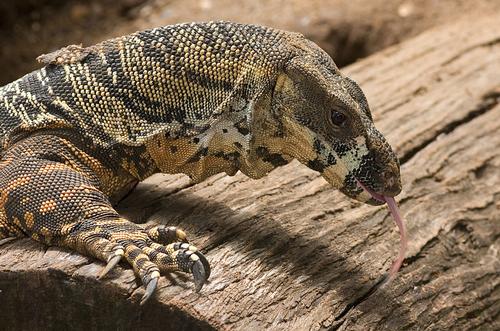 Goanna AustraliaPhoto: Lyle Radford CC 2.0 Generic no changes made
Goanna AustraliaPhoto: Lyle Radford CC 2.0 Generic no changes made
Australia has almost 400 species of reptiles, including crocodiles, more than 100 snakes (including, in addition to very poisonous, also large strangling snakes, pythons), more than 200 lizards, including 15 monitor lizards, the largest local concentration of this family of giant lizards and (endemic) freshwater turtles. The giant monitor lizard or goanna can grow up to two meters long. The perention lizard can also be several meters long.
Most snake species are harmless, but brown snake, death viper, taipan and tiger snake are poisonous. Well-known lizards are the grotesque mountain devil or moloch and the frilled lizard. There are two types of crocodiles in Australia, the river mouth crocodile or saltwater crocodile (also called boeaja) and the smaller Johnston or freshwater crocodile. The first species can grow up to seven meters long, the second species grows up to four meters.
Six of the seven sea turtle species are found in Australia, including the green turtle and the fathead turtle.
The amphibians only include frogs and toads. The miniature frog is a stomach breeder, which means that she is raising her young in her stomach. In the arid center of Australia, a toad species lives that sucks with water and then disappears underground to survive the long, dry time. The giant "Queensland cane toad" was introduced to fight a parasite that affected the sugar cane, but has become a pest.
In total there are about 55,000 species of insects, of which almost 20,000 beetles. The other invertebrates are often very peculiar, for example the giant earthworm that can grow up to three meters long.
Ball spiders and funnel spiders are extremely poisonous among the approx. 1500 spider species. Termites are mainly found in the north of Australia, where countless, sometimes three meter high, termite mounds are found. The many flies, mosquitoes and grasshoppers are a real pest for humans, animals and crops.
Fish
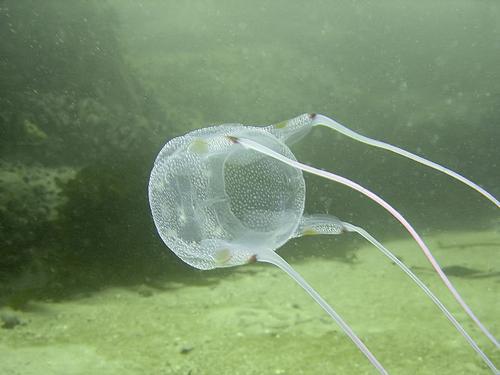
The seas around Australia are home to a very rich fauna, of which the Great Barrier Reef (a series of coral islands) enjoys worldwide fame. Numerous sea creatures are limited in their distribution to the seas around Australia. Dangerous are the blue-ringed eight-arm, an octopus species, the "box jellyfish" or cube jellyfish (also called sea wasp), hedgehog fish, stone fish, rays, the Portuguese warship (jellyfish species) and the crown of thorns, a kind of starfish. About 20 species of sharks are found in Australian waters. The most dangerous for humans are the tiger shark and the white shark. The whale shark is the largest fish in the world and lives in the Ningaloo Marine Park of Western Australia, among others.
Marlins are swordfish that can weigh up to 700 pounds. The snapper is the most commonly caught fish in Australia.
Particular in shape and color are the anthias, which are almost luminous, the bright red clownfish, the three-banded clownfish and the Maori wrasse. The curious looking pegasus fish is one of the symbols of the Australian seas.
Freshwater fish are not very rich in species (less than 200 species) and, for example, carp-like fish are completely absent. Its most notable form is the archaic Australian lungfish or barramundi of Queensland, a remnant of a once-widespread group of freshwater fish.
In 2022 it was announced that scientists in Australia discovered a previously unknown species of crab. The "extremely fluffy" animal belongs to the family of sponge crabs. Sponge crabs disguise themselves with hairs from other marine animals. But where other sponge crabs have a thinner 'coat', this crab has a 'coat' that completely covers the top of its body. According to the scientists, this type of crab uses its hairs as a shield, similar to what hermit crabs do. By camouflaging itself, the crab can avoid predators.
Sources
Australië
Cambium
Blutstein, H. / Insider's guide Australië
Kümmerley & Frey
Dolce, L. / Australia
Chelsea House Publishers
Elder, B. / Australië
Van Reemst
Ivory, M. / Australië
Van Reemst
Jansen van Galen, B. / Reishandboek Australië
Elmar
Viedebantt, K. / Australië
Van Reemst
CIA - World Factbook
BBC - Country Profiles
Last updated November 2025Copyright: Team The World of Info